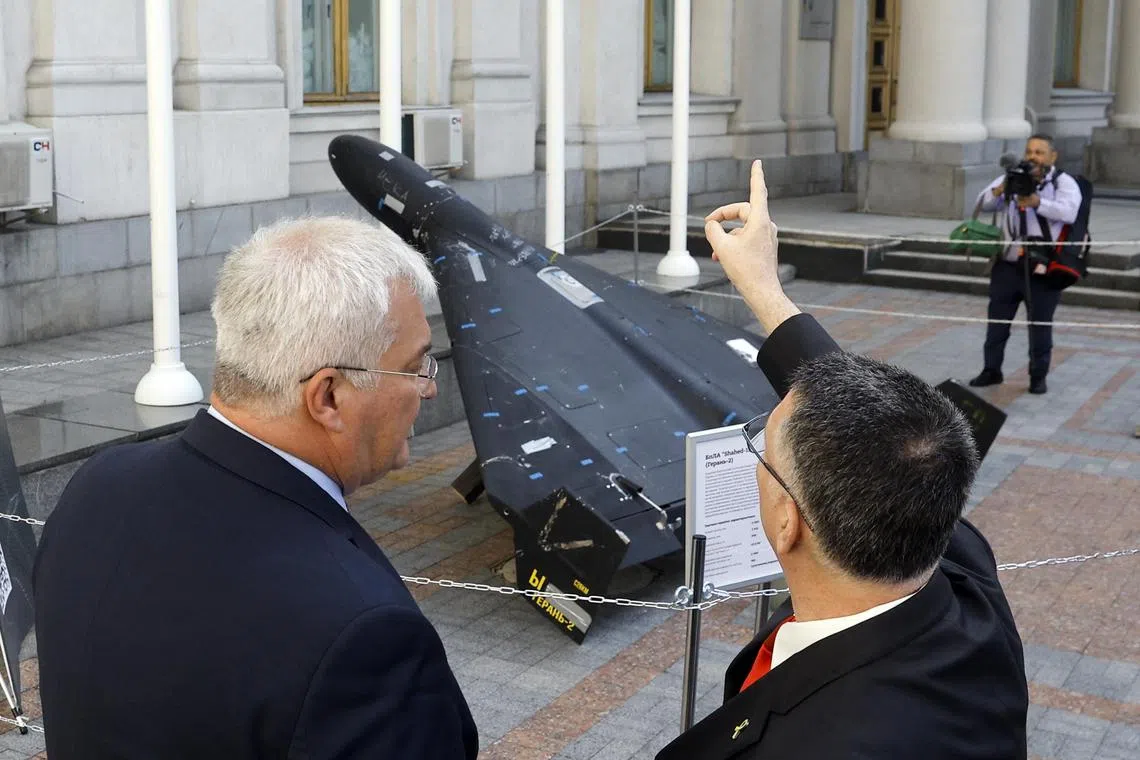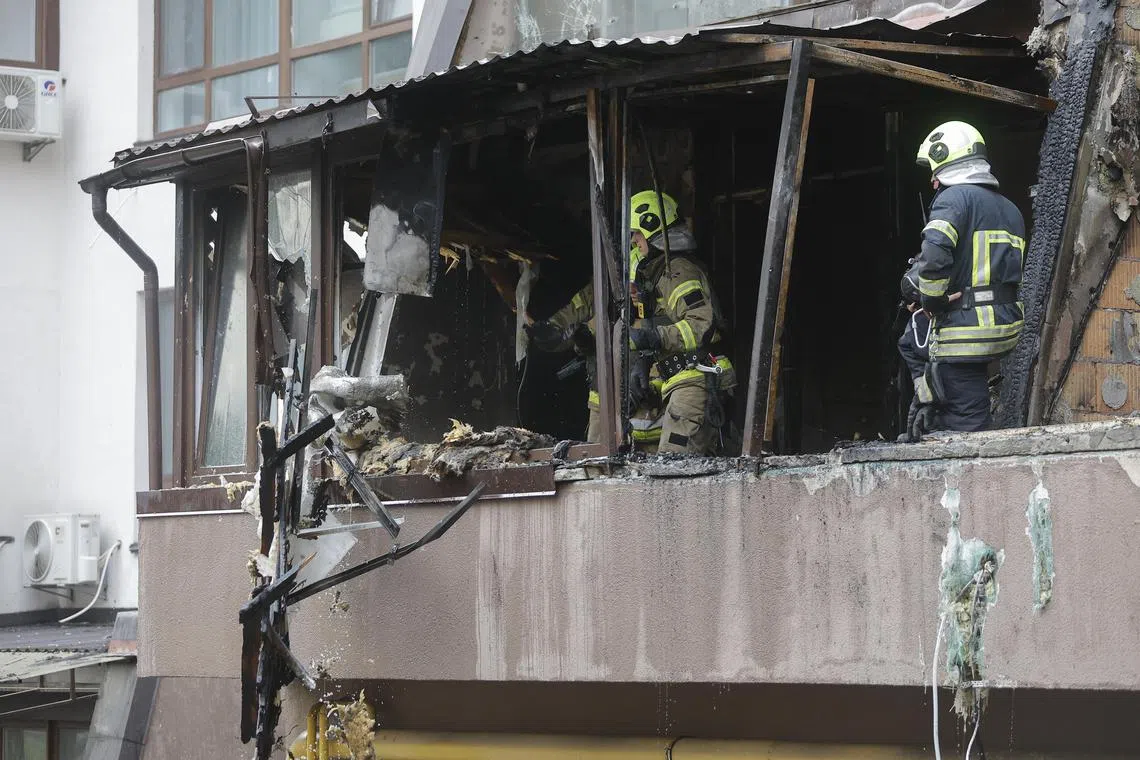Chinese engines, shipped as ‘cooling units’, power Russian drones used in Ukraine
Sign up now: Get ST's newsletters delivered to your inbox

Ukrainian Foreign Minister Andrii Sybiha (left) and visiting Israeli Foreign Minister Gideon Saar viewing a Russian drone in Kyiv, Ukraine, on July 23.
PHOTO: EPA
Follow topic:
- Chinese engines are covertly shipped to Russia's IEMZ Kupol via front companies, labelled as "industrial refrigeration units" to evade sanctions.
- This allows Kupol to increase Garpiya-A1 drone production, despite sanctions, with over 1,500 drones already delivered by April 2024.
- The EU urges China to stop trade sustaining Russia's military, amid concerns that Chinese firms' support threatens European security.
AI generated
LONDON - Chinese-made engines are being covertly shipped via front companies to a state-owned drone manufacturer in Russia, labelled as “industrial refrigeration units” to avoid detection in the wake of Western sanctions, according to three European security officials and documents reviewed by Reuters.
The shipments have allowed Russian weapon maker IEMZ Kupol to increase its production of the Garpiya-A1 attack drone, despite the US and EU sanctions imposed in October designed to disrupt its supply chain, according to the sources and documents, which included contracts, invoices and customs paperwork.
An internal Kupol document, reviewed by Reuters, showed it signed a contract with the Russian Defence Ministry to produce more than 6,000 Garpiya in 2025, up from 2,000 in 2024. The document stated that more than 1,500 drones had already been delivered by April.
The long-range drone is being deployed to attack civilian and military targets deep within Ukrainian territory, with around 500 being used by Russia a month, the Ukrainian military intelligence agency said in a statement to Reuters.
The European security officials asked that neither they nor their organisation be identified due to the sensitivity of the information. They also requested some specific details in the documents be withheld, such as their dates and the cost of contracts.
In September, Reuters reported that Kupol was producing the Garpiya using Chinese technology, including L550E engines made by Xiamen Limbach Aviation Engine.
A month after the Reuters’ report, the European Union and the US sanctioned several companies involved in producing the drones, including Xiamen.
In the wake of the sanctions, a new Chinese firm called Beijing Xichao International Technology and Trade has started supplying the L550E engines to Kupol, according to invoices, a Kupol internal letter and transportation documents reviewed by Reuters.
The increase in production of Garpiya as well as the new intermediaries supplying parts for the drones are reported by Reuters for the first time.
The news agency could not determine how Xichao obtained the engines from the maker Xiamen Limbach.
Xiamen Limbach did not respond to a request for comment and Reuters was unable to reach Xichao.
IEMZ Kupol, Russia’s Trade and Industry Ministry and the Defence Ministry also did not respond to a request for comment.
In a statement to Reuters, China’s Foreign Ministry said it was unaware of the export of parts for the Garpiya, and it has controlled foreign sales of dual-use goods in line with China’s own laws and international obligations.
“China has always opposed unilateral sanctions that lack basis in international law and are not authorised by the UN Security Council,” the statement said.
The European Commission did not immediately respond to a request for comment.

Ukrainian rescuers working at the site of a Russian drone strike on a residential building in Kyiv on July 21.
PHOTO: EPA
Both the US and EU have repeatedly imposed sanctions on companies in third-party countries, including China, alleged to have provided dual-use technology to Russia.
Kupol has been sanctioned since December 2022 by the EU and December 2023 by the US for its involvement in Russia’s defence sector.
Diplomatic warnings
European Commission president Ursula von der Leyen is due to travel to China for a summit with Chinese President Xi Jinping and Premier Li Qiang on July 24, amid tensions over Beijing’s support for Russia’s war effort.
The European Union’s top diplomat Kaja Kallas told Chinese Foreign Minister Wang Yi on July 2 that Chinese firms’ support for Russia in the war posed a threat to European security, and she urged China to cease trade that sustains Russia’s military machine, the EU said in a statement.
Ms Meia Nouwens, senior fellow for Chinese security and defence policy at the London-based International Institute for Strategic Studies, said China’s prime concern was to help sustain Russia’s war effort to ensure the US remained focused on Ukraine.
“This does not help China and Europe come closer together, diplomatically,” she said.
China says it imposes strict controls on the export of drones and their parts, and has never provided either side of the war in Ukraine with lethal weapons.
A person familiar with Beijing’s thinking on the issue said that China produces around 75 per cent of world’s drones, with the majority not for military purposes; if Russia was using them as weapons, then the same was also true of Ukraine, the person added.
Ahead of the July 24 summit, one European official said the EU was not asking China to cut economic ties with Russia, but to strengthen customs and financial controls to reduce the flow of specific dual-use goods.
The Garpiya, which means harpy in Russian, is based on the Iranian-made Shahed drones but relies on Chinese technology, the three European sources said.
The Ukrainian military intelligence agency said the Chinese-made components in the drone included the engine, control systems and navigation equipment.
The engines were shipped by Xichao to a Russian front company identified as SMP-138, which then forwarded them to a second Russian firm LIBSS, according to another internal Kupol document, seen by Reuters.
Mr Abram Goldman, registered as the owner of SMP-138, did not respond to an e-mailed request for comment.
LIBSS also did not respond to Reuters’ questions.
A contract for LIBSS to supply Kupol with the engines, reviewed by Reuters, stated they would be described as cooling units in shipping documents because of their sensitivity.
The delivery route was from Beijing to Moscow then to Izhevsk, where Kupol has manufacturing facilities.
Describing them as cooling units allowed the goods to be exported to Russia without alerting the Chinese authorities, the three security officials said.
Transportation documents reviewed by Reuters showed that Sichuan Airlines and China Southern Airlines, China’s largest carrier, had transported components for the drones to sanctioned Russian companies since October.
China Southern did not respond to Reuters’ questions and Sichuan could not be reached for comment. REUTERS

